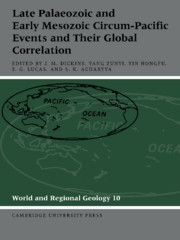Book contents
- Frontmatter
- Contents
- List of contributors
- Preface
- 1 Major global change: framework for the modern world
- 2 Carboniferous-to-Triassic evolution of the Panthalassan margin in southern South America
- 3 Permian and Triassic geologic events in Sonora, northwestern Mexico
- 4 Advances in the correlation of the Permian
- 5 Examples of late Hercynian transtensional tectonics in the Southern Alps (Italy)
- 6 Succession of selected bioevents in the continental Permian of the Southern Alps (Italy): improvements in intrabasinal and interregional correlations
- 7 Permian chronostratigraphic subdivisions and events in China
- 8 Indosinian Tectogeny in the geological correlation of Vietnam and adjacent regions
- 9 Sitsa flora from the Permian of South Primorye
- 10 Late Permian bimodal volcanism in South Primorye
- 11 Syngenetic and epigenetic mineral deposits in Permian and Triassic sequences of the Primorye region
- 12 The mid-Permian: major changes in geology, environment, and faunas and some evolutionary implications
- 13 Variations in the disappearance patterns of rugosan corals in Tethys and their implications for environments at the end of the Permian
- 14 Fluctuations in pelagic environments near the Permian–Triassic boundary in the Mino-Tamba Terrane, southwest Japan
- 15 Late Changxingian ammonoids, bivalves, and brachiopods in South Primorye
- 16 Radiolaria from Permian–Triassic boundary beds in cherty deposits of Primorye (Sikhote-Alin)
- 17 Early Mesozoic magmatism in the Russian Far East
- 18 Transgressive conodont faunas of the early Triassic: an opportunity for correlation in the Tethys and the circum-Pacific
- 19 Triassic biostratigraphy and palaeobiogeography of East Asia
- 20 Classification and correlation of Triassic limestones in Sikhote-Alin on the basis of corals
- 21 Evolution of the platform elements of the conodont genus Metapolygnathus and their distribution in the Upper Triassic of Sikhote-Alin
- 22 Late Triassic North American halobiid bivalves: diversity trends and circum-Pacific correlations
- 23 Upper Triassic Chinle Group, Western United States: a nonmarine standard for late Triassic time
- 24 Otapirian Stage: its fauna and microflora
- 25 Upper Palaeozoic glaciation and Carboniferous and Permian faunal changes in Argentina
- Index
18 - Transgressive conodont faunas of the early Triassic: an opportunity for correlation in the Tethys and the circum-Pacific
Published online by Cambridge University Press: 13 October 2009
- Frontmatter
- Contents
- List of contributors
- Preface
- 1 Major global change: framework for the modern world
- 2 Carboniferous-to-Triassic evolution of the Panthalassan margin in southern South America
- 3 Permian and Triassic geologic events in Sonora, northwestern Mexico
- 4 Advances in the correlation of the Permian
- 5 Examples of late Hercynian transtensional tectonics in the Southern Alps (Italy)
- 6 Succession of selected bioevents in the continental Permian of the Southern Alps (Italy): improvements in intrabasinal and interregional correlations
- 7 Permian chronostratigraphic subdivisions and events in China
- 8 Indosinian Tectogeny in the geological correlation of Vietnam and adjacent regions
- 9 Sitsa flora from the Permian of South Primorye
- 10 Late Permian bimodal volcanism in South Primorye
- 11 Syngenetic and epigenetic mineral deposits in Permian and Triassic sequences of the Primorye region
- 12 The mid-Permian: major changes in geology, environment, and faunas and some evolutionary implications
- 13 Variations in the disappearance patterns of rugosan corals in Tethys and their implications for environments at the end of the Permian
- 14 Fluctuations in pelagic environments near the Permian–Triassic boundary in the Mino-Tamba Terrane, southwest Japan
- 15 Late Changxingian ammonoids, bivalves, and brachiopods in South Primorye
- 16 Radiolaria from Permian–Triassic boundary beds in cherty deposits of Primorye (Sikhote-Alin)
- 17 Early Mesozoic magmatism in the Russian Far East
- 18 Transgressive conodont faunas of the early Triassic: an opportunity for correlation in the Tethys and the circum-Pacific
- 19 Triassic biostratigraphy and palaeobiogeography of East Asia
- 20 Classification and correlation of Triassic limestones in Sikhote-Alin on the basis of corals
- 21 Evolution of the platform elements of the conodont genus Metapolygnathus and their distribution in the Upper Triassic of Sikhote-Alin
- 22 Late Triassic North American halobiid bivalves: diversity trends and circum-Pacific correlations
- 23 Upper Triassic Chinle Group, Western United States: a nonmarine standard for late Triassic time
- 24 Otapirian Stage: its fauna and microflora
- 25 Upper Palaeozoic glaciation and Carboniferous and Permian faunal changes in Argentina
- Index
Summary
Ammonoids have long provided the basis for age assignments and correlations of Lower Triassic (Scythian) marine strata. Although the early Triassic marine faunas were of low diversity and abundance relative to those of the late Permian, ammonoids are widely distributed in Scythian strata. Areas with Lower Triassic fossiliferous marine rocks, including ammonoids, are shown in Figure 18.1. Some 136 ammonoid genera are recognized for the Scythian (Kummel, 1973), and various zonal schemes show detailed subdivisions of that important geologic interval (Tozer, 1967, 1974; Silberling and Tozer, 1968). However, ammonoids are not always present in sufficient numbers for biostratigraphic use.
Coincident with the widespread use of acetic acid for dissolution of conodont-bearing carbonate rocks, the recovery and study of these small phosphatic elements provided a distinctive and cosmopolitan microfossil alternative for Triassic marine biostratigraphy.
Lower Triassic conodonts and evolution of a zonation
Early studies of conodont elements focused primarily on the stratigraphic distribution of diagnostic forms, and the literature burgeoned. By 1950, widespread conodont faunas from Ordovician rocks through Permian rocks had been described in the United States. A full description of a Lower Triassic conodont fauna, however, was not published until the work of Müller (1956) in Nevada, who also suggested the potential for a timesignificant biostratigraphic succession. Later, Sweet's prototype Lower Triassic zonation, based on comprehensive collections from West Pakistan, stimulated worldwide study of equivalent faunas (Sweet, 1970).
- Type
- Chapter
- Information
- Late Palaeozoic and Early Mesozoic Circum-Pacific Events and their Global Correlation , pp. 158 - 167Publisher: Cambridge University PressPrint publication year: 1997
- 3
- Cited by



